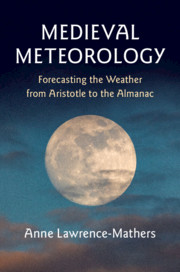Book contents
- Medieval Meteorology
- Medieval Meteorology
- Copyright page
- Contents
- Preface
- Acknowledgements
- Introduction
- 1 Recreating Meteorology in the Early Middle Ages
- 2 Meteorology, Weather Forecasting and the Early Medieval Renaissance of Astronomy
- 3 Exploratory Encounters with the Work of Arab Astronomers and Meteorologists
- 4 Meteorology, the New Science of the Stars and the Rise of Weather Forecasting
- 5 The Contested Rise of Astrometeorology
- 6 Applying the Science of Astrometeorology
- 7 Astrometeorology and Mechanisation
- 8 Weather Forecasting and the Impact of Print
- Conclusion
- Bibliography
- Index
6 - Applying the Science of Astrometeorology
Published online by Cambridge University Press: 08 November 2019
- Medieval Meteorology
- Medieval Meteorology
- Copyright page
- Contents
- Preface
- Acknowledgements
- Introduction
- 1 Recreating Meteorology in the Early Middle Ages
- 2 Meteorology, Weather Forecasting and the Early Medieval Renaissance of Astronomy
- 3 Exploratory Encounters with the Work of Arab Astronomers and Meteorologists
- 4 Meteorology, the New Science of the Stars and the Rise of Weather Forecasting
- 5 The Contested Rise of Astrometeorology
- 6 Applying the Science of Astrometeorology
- 7 Astrometeorology and Mechanisation
- 8 Weather Forecasting and the Impact of Print
- Conclusion
- Bibliography
- Index
Summary
Chapter 6 traces the spread of astrometeorology and detailed weather forecasting amongst the lay and ecclesiastical elite. It discusses the distinctions made between varying forms of astrology, before analysing a treatise attributed to Robert Grosseteste. This offers a worked example of a weather forecast for 15 April 1249. The chapter argues that such forecasts were in accord with other works by Grosseteste. It goes on to consider the place of accepted forms of astrology in thirteenth-century university study. An important point is that Aquinas’ Summa Theologiae established weather forecasting as distinct from divination. Equally important is the evidence of the Mirror of Astronomy attributed to Albertus Magnus. This discusses astrometeorology in detail, and gives a list of approved works on the subject. The chapter concludes that this endorsement was very important, given the growing concern about necromancy and divination. Analysis of contemporary enclyclopedias demonstrates the authors’ very cautious acceptance of the basics of astrometeorology. In contrast, secular rulers such as Frederick II openly employed astrologers like Michael Scot and Guido Bonatti, whose contributions to astrometeorology are discussed.
Keywords
- Type
- Chapter
- Information
- Medieval MeteorologyForecasting the Weather from Aristotle to the Almanac, pp. 134 - 151Publisher: Cambridge University PressPrint publication year: 2019

